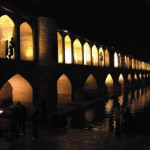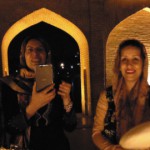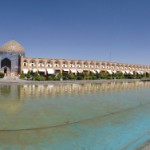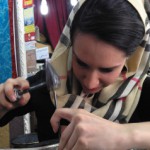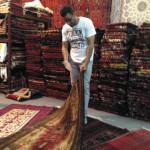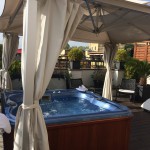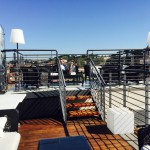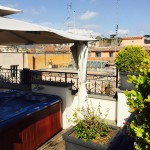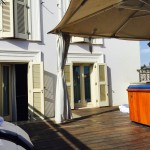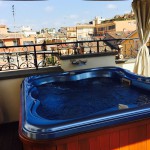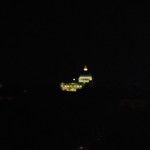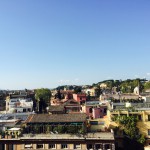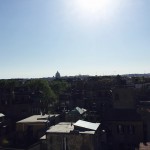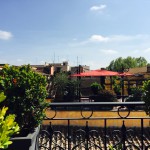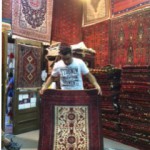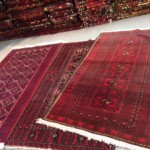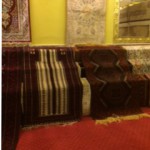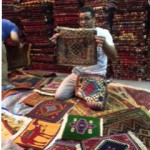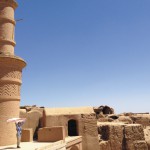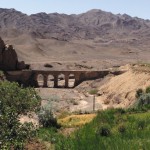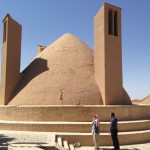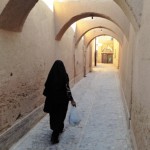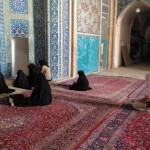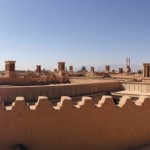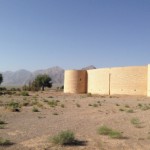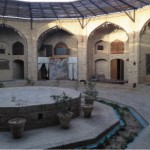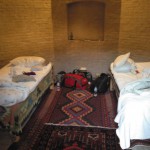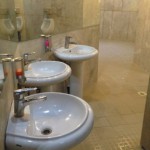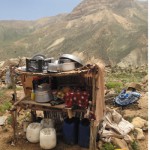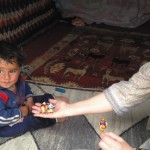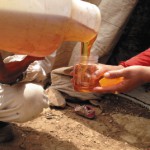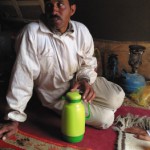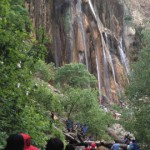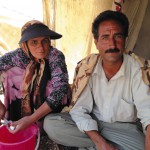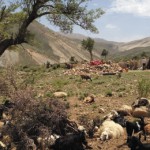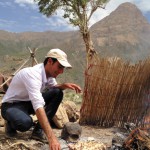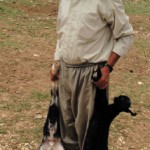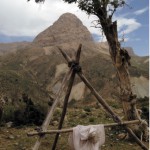I doubt that any city of this country can measure with Esfahan (or Isfahan) as for the beauty of its religious places. We did not hesitate a minute after our arrival from Yazd and as the sun was setting down on the horizon we strolled on the north river bank (exceptionally w/water!) towards the Se Si Pol („33“) bridge, named after thirty three arches carrying pedestrians between north and south parts of this beautiful town, enjoying the evening, taking pictures and in some cases, risking violation of Islamic Law, holding hands. And as always we were approached by many locals every few yards to take pictures with them. You can hardly move forward, but it was amazing. This was more a lesson on the civic life common people enjoy in that sliver of daily life government still hasn’t managed to interfere with.
In the morning we decided to go to the very center of the city life where the commerce and religion seem to live in a symbiotic relationship. The huge square fifteen hundred feet long and five hundred feet wide, aptly named „Half the World“, was historically a market place and only later came shahs with different royal ideas of moving the market into arcades thus converting the emptied space surrounded by them into military parading grounds and adding the spiritual centers to feed the common people souls so they would not come up with inappropriate or crazy or, God forbid, dangerous ideas about their own lives. Of course those spiritual centers, mosques, have to follow the general rules of layout such as the mihrab (equivalent of altar in Christian spiritual facilities) facing Mecca. Damn it, as the shah discovered soon, it did not comply! Why? Because the original market place lay out, set in place well before shah Abbas The First decided to pursue his megalomanic dreams of worldwide architectural recognition, screwed his majesty’s master plan big because it was laid out on a simple NorthSouth axis!
In the year 1610AD, or as they like to say here 1600CE (not Christian Era, but Common Era), it was too late to change it and to make it work both mosques must have been connected with the arcades by weird corridors no matter what artistry was employed. Frankly, the smaller mosque, with a rather difficult Arabic name which we renamed with a more memorable and similarly sounding English nickname, the Lollipop Mosque, is a more striking architectural accomplishment and its inner dome is an exquisite example of what can be done in tiles. We should have seen this before we started our own bathrooms remodel in striking white in our Orinda home. Well, too late, my friends!
The skillful workforce of Lollipop Mosque, the mosque which was possibly used by many women in Shah’s harem, was then redirected to the bigger mosque’s construction site. This mosque was supposed to secure shah Abbas I place in history as the greatest shah, but clearly it did not proceed well and was from the start loaded with issues known to humans since the beginning of time. The delays and budget overruns!
Shah became nervous, then pushy, and tried to cut corners. And the result? Shabby quality, tiles and plaster falling off the walls, the paint with life time warranty being washed down by the next rain. Fortunately, poor shah passed away before the first rain hit unfinished Super Dome, so warranty was fulfilled to the full extent both word and spirit of the contract. Therefore no claim has ever been filed. Not enough lawyers at that time helped a little bit as well. But this mosque has been under repair ever since! Meanwhile women of Esfahan have led satisfactory spiritual lives since shah Abbas I times, and they have also enjoyed working in the weaving carpet and other workshops day after day for a generous salary of $20 a year after year after year. Some of those women, unreasonable unhappy were even allowed during their comfortable time of individual confinement in the hot workshops to wear a scarf with a full freedom of moving away from standard black (sometime Burberry latest models were allowed as long as they were not worn home in front of their mentally exhausted husbands), and of course, the nail polish should have been removed, not to effect their productivity!
And the spiritually unfulfilled men, because their mosque is still unfinished, have been appropriately punished by being assigned to extremely hard jobs of drinking tea, discussing with their fellow male vendors the difficulties of the physically demanding and miserable lives of spreading carpets made by THEIR WIVES, sometime even twice (!) a day, presenting them to WIVES of those ungrateful infidels with obscene piles of rials in their expensive purses. How happy those men could be if they were allowed to switch roles with their own wives! Only by unfortunate turn of events, as explained by one rather runty carpet dealer, their muscles were disgustingly bigger, their fingers incredibly clumsy and even more unfortunately, the male brain less suited to spend their days in the workshops. As a result they will have to go on drinking more tea while their wives feel sorry for them.
I had an excellent opportunity to discuss such interesting issues of our time with the first mullah of the Great Shah Mosque as we met in the courtyard of his residence where he was recuperating after his modest lunch and trying to catch breath. I was quite impressed by this young intelligent gentleman who was more than capable to clarify some of my ideas and opinions on roles of both genders in the society. As we proceeded deeper and deeper in our analyses I was willing to admit that some of my ideas were on the border line or, I do not hesitate to say, dangerously close to blasphemy! Contrary to what I heard when talking to the people during our visit to his beautiful country, vast majority of population is very happy how the government protects them. And those eternal complainers? We will work on them hard, he assured me, until they are happy! And it is the way it should remain for many years to come.

